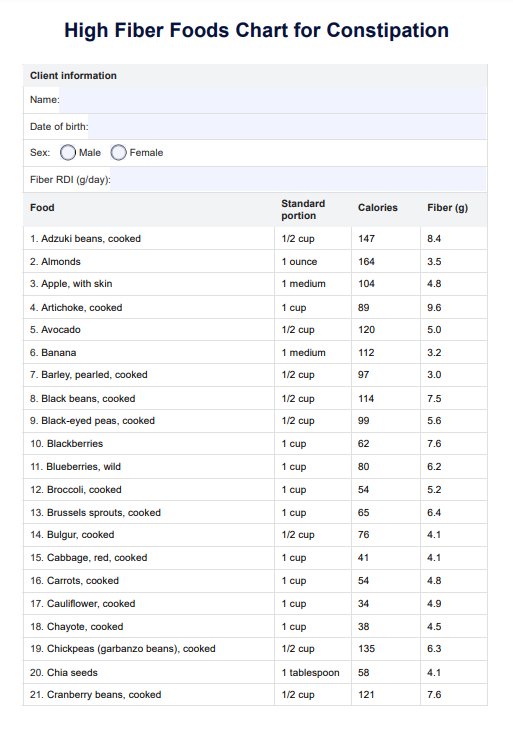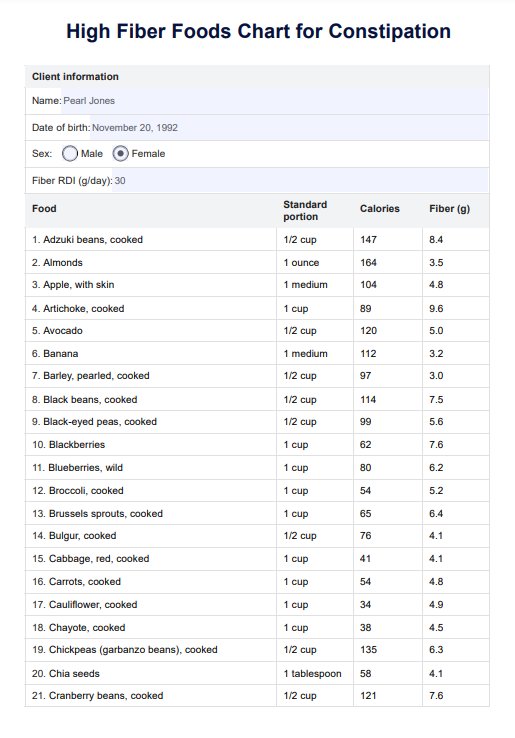High Fiber Foods Chart for Constipation
Download our High Fiber Foods Chart for Constipation. Boost your client's digestive system and improve gut health naturally.


What is a High Fiber Foods Chart for Constipation?
A High Fiber Foods Chart for Constipation is a quick reference guide to foods that can help your clients reach their daily fiber goals and ease constipation symptoms. This handy chart is also designed to remedy especially chronic constipation in the short term and spark inspiration for shopping lists, meal planning, or snack options that boost fiber.
Fiber helps increase fullness, lower blood sugar and cholesterol, and aid digestion by feeding our beneficial gut bacteria. Despite these clear benefits, as many as 95% of us may need to reach our recommended dietary intake (RDI) of fiber (Quagliani & Felt-Gunderson, 2017).
To help your clients reach the recommended amount of fiber, it's essential to tailor a high fiber meal plan to their preferences, lifestyle, and overall health. Some foods high in fiber include whole wheat pasta, sunflower seeds, chia seeds, pumpkin seeds, and other plant foods.
However, it's important to note that consuming too much fiber can lead to complications, such as digestive system issues like bloating, gas, and diarrhea. To advise them properly, assess their condition first if they have irritable bowel syndrome or inflammatory bowel disease.
Therefore, it's crucial to strike a balance and ensure that fiber intake aligns with individual needs and tolerances. That's where our High Fiber Foods Chart for Constipation can help. This chart includes 50 different high fiber foods and a guide of how much fiber and calories are in one standard portion.
High Fiber Foods Chart for Constipation Template
High Fiber Foods Chart for Constipation Example
How does it work?
Follow the simple steps below to use our High Fiber Foods Chart to help your clients struggling with their bowel movements move again.
Step 1: Download the chart
The first step is to download the free, printable High Fiber Foods Chart for Constipation using the link on this page. If you prefer, you can print out the PDF to complete additional notes by hand.
Step 2: Assign the list to your client
Next, share the PDF with your client. You can do this through email, a secure messaging platform, or by providing a link to the template within the Carepatron platform.
Step 3: Add in any additional high fiber foods
This high fiber foods list printable resource covers a broad spectrum of fiber-rich foods. But if there are specific foods your client enjoys or that align with their dietary preferences, consider adding them to the list. Instruct them to increase fiber intake gradually and assess if there is a need to incorporate a fiber supplement into their diet.
Step 4: Add any extra notes
Emphasizing the importance of incorporating more fiber-rich foods such as fruits, vegetables, and whole grains into your patient's high fiber diet plan for improved digestive health is vital. If necessary, consider recommending fiber supplements to help them meet their recommended daily intake and support optimal digestion.
Who can use this list?
Dietary fiber, including insoluble and soluble fiber, can have various digestive health benefits. For clients struggling with constipation, a fiber diet plan can be just what they need to get things moving more regularly. Health professionals who may benefit from incorporating this list of high fiber foods chart into their practice include:
- Dietitians
- Nutritionists
- Primary care providers
- Fitness coaches
- Personal trainers
- General practitioners
It can be a visual reference for your clients to reinforce positive food choices to help ease their digestive symptoms. However, it is essential to remember that in some cases, excess dietary fiber above and beyond the recommended intake can exacerbate symptoms such as constipation.
Research and evidence
Dietary fiber is pivotal in treating constipation by absorbing water in the digestive tract, resulting in softer stools that are easier to pass. Insoluble fiber also adds bulk to stools, aiding in regular bowel movements. Hence, it is essential to encourage adequate water intake alongside increased fiber consumption. Extra caution should be taken when recommending fiber intake above the RDI set by the Institute of Medicine. The recommended daily fiber intake is 25 grams for women aged 19-50, 38 grams for men aged 19-50, 21 grams for women aged 51 and older, and 30 grams for men aged 51 and older. (Akbar & Shreenath, 2023).
Denis Parsons Burkitt conducted some of the earliest research into the benefits of dietary fiber in the 1960s and 70s following his return from working as a surgeon in Africa. Burkitt's experiments investigated colonic transit time amongst populations with high dietary fiber intake, such as those he encountered during his time in Africa, and populations with low dietary intake, such as those in his home country of England. In collaboration with other researchers throughout the late 20th century. Although Burkitt was investigating the effects of dietary fiber we are now familiar with today, it wasn't until 1972 that a physician inspired by the work of Burkitt, Hugh Trowell, coined the term "dietary fiber" (Cummings & Engineer, 2018).
The exact definition of this term would remain in some dispute over the years, with varying definitions in certain instances. Despite difficulties in pinning down the precise definition of dietary fiber, the health advantages of dietary fiber are widely acknowledged and endorsed by reputable organizations like the American Heart Association.
While our bodies cannot directly digest fiber, the beneficial bacteria in our gastrointestinal tract can benefit from the fiber we ingest. By fostering the growth of protective bacteria through prebiotic dietary fiber, improvements in digestion, reduced reliance on insulin, and even assistance in weight loss have been observed in both animals and humans (Parnell & Reimer, 2012; Megur et al., 2022).
References
Akbar, A., & Shreenath, A. P. (2023, May 1). High fiber diet. PubMed; StatPearls Publishing. https://www.ncbi.nlm.nih.gov/books/NBK559033/
Cummings, J. H., & Engineer, A. (2018). Denis Burkitt and the origins of the dietary fibre hypothesis. Nutrition Research Reviews, 31(1), 1–15. doi:10.1017/S0954422417000117
Megur, A., Daliri, E. B.-M., Baltriukienė, D., & Burokas, A. (2022). Prebiotics as a tool for the prevention and treatment of obesity and diabetes: Classification and ability to modulate the gut microbiota. International Journal of Molecular Sciences, 23(11), 6097. https://doi.org/10.3390/ijms23116097
Parnell, J. A., & Reimer, R. A. (2012). Prebiotic fiber modulation of the gut microbiota improves risk factors for obesity and the metabolic syndrome. Gut Microbes, 3(1), 29–34. https://doi.org/10.4161/gmic.19246
Quagliani, D., & Felt-Gunderson, P. (2017). Closing America's fiber intake gap: Communication strategies from a food and fiber summit. American Journal of Lifestyle Medicine, 11(1), 80–85. https://doi.org/10.1177/1559827615588079
Commonly asked questions
High fiber foods charts are typically requested by individuals conscious of their dietary choices and health enthusiasts seeking to increase their fiber intake. Health professionals, such as dietitians and nutritionists, may also use these charts for clients who could benefit from increasing their dietary fiber intake.
They can be used when individuals want to improve their digestive health, manage weight, or address specific health concerns. They are often employed during dietary consultations, wellness programs, or as part of a broader effort to promote a balanced, fiber-rich diet.
Although dietary fiber can relieve constipation through water absorption and bulking of stools, overly high fiber diets can have the opposite effect. As such, if you are already reaching your fiber RDI, excess fiber above this is unlikely beneficial and could worsen your digestive problems. It's essential to consult with a dietitian or nutritionist in these cases.
Green peas and green beans are excellent sources of fiber, as are other vegetables like broccoli and carrots, fruits like apples and berries, and whole grains such as whole wheat bread. Including these in your diet can promote a healthy digestive system.










































































































